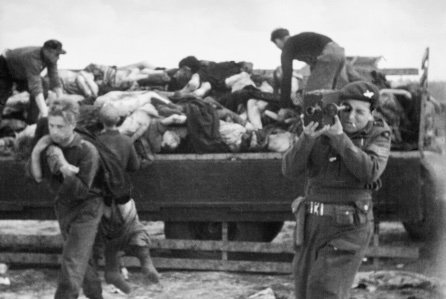Although Allied governments from Moscow to Washington had reliable information about the wholesale slaughter of Jews going on in the death camps, as well as on the infamous "death marches," the liberation of the camps was not a strategic objective of the Allies, but a consequence of their military campaign.
Between August 1944 and April 1945, Allied soldiers, together with camera teams, discovered Nazi German extermination camps in Poland and concentration camps in Germany. Contrary to common thought, the first films shot in the concentration camps did not document the atrocities committed there in real time. Rather, the Allied information films about the discovery of the camps were created by seasoned professionals, and, despite the limitations of their scope and their distribution, with time these films became historical documents, determining the world's collective memory by means of their iconographic images.
Majdanek in Poland was the first camp to be discovered. Red Army troops reached the camp in July 1944, accompanied by the finest war correspondents and filmmakers, most notably Roman Karmen, a veteran Soviet Russian photojournalist, and Alexander Ford, one of the fathers of Polish cinema in the twentieth century. Ford and Karmen were faced with the challenge of making a film of a site of mass murder on an unprecedented scale.
The film Extermination Camp Majdanek: Cemetery of Europe (Alexander Ford, 1944) created a new cinematic language, which determined, to a great extent, the filmic representation of the concentration camp. Depth-of-field shots of massive rows of electrified barbed-wire fences generate an image of horror. In another sequence, a traveling shot reveals a row of people standing behind a barbed-wire fence. Though the people in the frame were actual prisoners at Majdanek, the sequence is staged to represent the point of view of the soldiers who burst into the camp. The dramatic tension in the shot, as well as its content, define a narrative of “liberation.”
Liberation films belong to the genre of crime-scene documentation, since they present the viewer with the traces left by the murderers who perpetrated atrocities. There are scenes of corpses, in the process of being buried or in a state of advanced decomposition, and images of objects related to wholesale annihilation, including interior shots of crematoria still exuding smoke, used Zyklon-B capsules, and mass graves. All of these shots were intended to make tangible the fact that an unprecedented crime had been revealed. Especially horrifying are the frames of piles of shoes, images that combine long shots of piles with close-ups of individual items: every suitcase, sandal and toy once belonged to a real person.
Aside from the fact that none of the liberation films actually documents mass murder in real time, the former prisoners in the camps are also voiceless and objectified – they never speak to the camera. Additionally, there is no reference to the unique fate of the Jews during the Holocaust, although the great majority of the surviving prisoners as well as the murdered victims in the films were, of course, Jewish.
The Cold War negatively affected the distribution of liberation films. Various versions in different languages were hastily edited, and excerpts were screened as evidence at the Nuremberg and Eichmann trials. Although most of the films saw public viewing shortly after the end of the war, almost all subsequently returned to the shelves, or were re-edited only many years later. A prime example is the British film German Concentration Camps: A Factual Survey (Sidney Bernstein, UK), the production of which was halted abruptly in 1945, among other reasons, as a result of British anti-Zionist policies at the time.
Bernstein, who traveled to Bergen-Belsen shortly after its liberation by British forces, was devastated by the experience, and decided to make a film documenting the discovery of the camps. For this purpose, he obtained Soviet footage shot at Majdanek and Auschwitz, as well as British footage from Bergen-Belsen.
But the British Ministry of Information stopped production in 1945, and it was only in 1984 that a partial version of the film was screened as part of a "Frontline" program on PBS. The restored version released in 2014 was produced by the Imperial War Museum. At the time of the latter film’s release, the documentary Night Will Fall (Andre Singer, 2014, UK) hit the screens, telling the story of Bernstein’s trials and tribulations attempting to make his film seventy years earlier.
The original intention of the Allies who made the liberation films with the finest of filmmakers was to document the atrocities committed in the camps, and to tell the story of their liberation. Yet after the Allies themselves decided to shelve the films not long after the war, excerpts from them appeared in documentary films, and provided thematic and visual inspiration for feature films, as representations of the atrocities themselves.
The author is Film Research and Acquisitions Coordinator, Visual Center.




